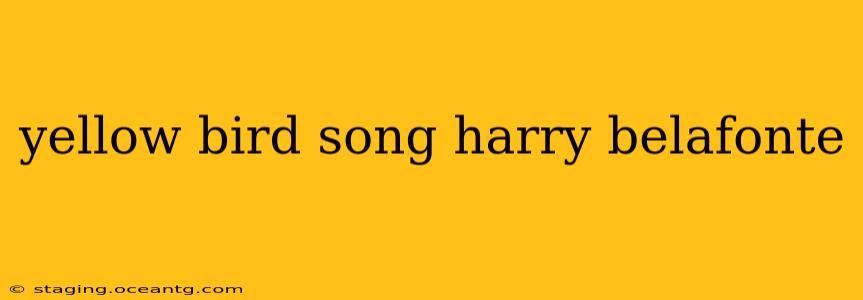Harry Belafonte's rendition of "Yellow Bird" is more than just a song; it's a cultural touchstone, instantly transporting listeners to sun-drenched Caribbean beaches. This iconic tune, with its simple melody and uplifting rhythm, has captivated audiences for decades, solidifying its place in musical history. But what makes this song so special, and what's the story behind its enduring popularity? Let's delve into the captivating world of "Yellow Bird."
What is the meaning of the song Yellow Bird?
The lyrics of "Yellow Bird" are deceptively simple, painting a picture of serene island life and the beauty of nature. The song speaks of a yellow bird singing sweetly, symbolizing joy and freedom. While the meaning isn't explicitly stated, interpretations often center on themes of appreciation for the simple pleasures in life, the beauty of nature, and the carefree spirit of the Caribbean. The repetitive nature of the lyrics enhances this feeling of tranquility and effortless joy. It's a song that invites listeners to relax, reflect, and appreciate the small wonders around them.
Who originally sang Yellow Bird?
While Harry Belafonte's version is undeniably the most famous, the origins of "Yellow Bird" are a bit more complex. The melody is often attributed to a traditional folk song from the Caribbean islands, passed down through generations. Various versions existed before Belafonte's recording, making it difficult to definitively pinpoint a single "original" artist. The lyrics, however, have evolved over time, with different artists adding their own unique touches. Belafonte's version, with its specific arrangement and vocal style, became the definitive interpretation for many.
What year did Harry Belafonte sing Yellow Bird?
Harry Belafonte's recording of "Yellow Bird" wasn't part of a major studio album release in the way some of his other hits were. Instead, it appeared on various compilation albums over the years, notably gaining significant traction in the late 1960s and early 1970s. The exact year of its initial recording remains somewhat uncertain, but its popularity soared during this period, solidifying its place in his repertoire and becoming a staple in his live performances. It's this widespread availability and enduring appeal that makes pinpointing a single release year less significant than its overall impact on popular culture.
How did Yellow Bird become so popular?
Several factors contributed to the immense popularity of Belafonte's "Yellow Bird." Firstly, the song's inherent beauty and simplicity resonated with a wide audience. Its upbeat tempo and catchy melody were infectious, making it easy to listen to and enjoy. Secondly, Belafonte's masterful vocals brought a warmth and authenticity to the song, perfectly capturing its island spirit. His already established reputation as a charismatic performer further amplified the song's reach. Finally, the song's association with the idyllic Caribbean lifestyle added to its allure, appealing to those seeking an escape from daily life.
What other songs did Harry Belafonte sing?
Harry Belafonte's musical career spans decades and encompasses a diverse range of genres, including calypso, folk, and traditional American songs. Some of his other notable hits include "Day-O (The Banana Boat Song)," "Jamaica Farewell," and "Matilda." These songs, like "Yellow Bird," often showcase his ability to connect with audiences through his warm vocals and his unique approach to diverse musical styles. He's a true icon, known not just for his music but also for his activism and humanitarian work.
Conclusion: A Legacy of Sunshine and Song
"Yellow Bird" remains a testament to the power of simple, beautiful music. Harry Belafonte's interpretation transcended generations, becoming a symbol of Caribbean joy and musical excellence. Its enduring popularity is a tribute to its timeless appeal and Belafonte's undeniable talent. The song continues to bring sunshine to listeners worldwide, a testament to the lasting legacy of both the artist and the song itself.
